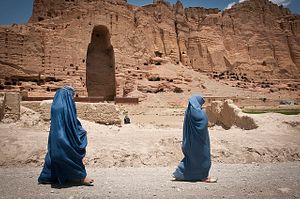The Islamic State’s bulldozing of statues, walls, and a castle in the ancient Assyrian capital of Nimrud drew international condemnation last week.
Writer Mohammad Rabia Chaar, speaking with Anne Barnard of The New York Times, was particularly sickened. “Daesh wants people wit no memory, with no history, with no culture, no past, no future,” Chaar said, referring to an Arabic derivation of the group’s name. ISIS even destroyed the winged bulls that adorn Iraqi currency, calling the statues “false idols.”
This is nothing new for militant groups. A week before the Nimrud attack, ISIS tore through Mosul, ransacking the city’s museum, library, and Nirgal Gate, taking sledgehammers to ancient Assyrian treasures, some which dated back to the 13th century. Before American forces drove Taliban militants out of Afghanistan in March 2001, Mullah Omar ordered the destruction of the Buddhas of Bamiyan, relics of the ancient Gandhara civilization, which inhabited the region in the sixth century CE.
But it’s not just armed militants that are destroying the treasures of antiquity. In Afghanistan, farmers, merchants, and vandals venture to the northern city of Balkh, once the crossroads of traders and conquerors like Genghis Khan and Tamerlane, in hopes of digging up ancient relics to bring to the illicit marketplace.
In Afghanistan, the black market for ancient treasures has become increasingly lucrative. With their eyes on keeping the peace, neither the government nor the army has the interest in punishing such crimes. For Afghans, preserving artifacts like the Bactrian Hoard, fine golden jewelry dating to the first century CE that was excavated just before the Soviet invasion in 1978, seems less important than dealing with basic human needs.
Certainly, culture ebbs and flows throughout history. The Ottomans papered over Christian relics in Constantinople’s Hagia Sophia, replacing them with emblems of Muslim calligraphy, which still adorn the walls of the mosque today. In the Afghan case, the looting is a symptom of the poverty that ails the country, not a cause of it.
But Afghanistan can aid in healing the scar tissue formed by over three decades of war and dictatorship by doing more to protect its history. “Antiques roadshows,” which allow Afghanistan to buy back its treasures at market value, have helped, but are just a small part of the solution. As archaeologists debate procedures to restore the dynamited Buddhas at Bamiyan, the government should take the lead in ensuring that the project is successful. By preserving the cultures of the past, Afghanistan’s fragile institutions can make a lasting impact.

































